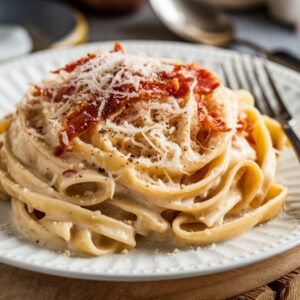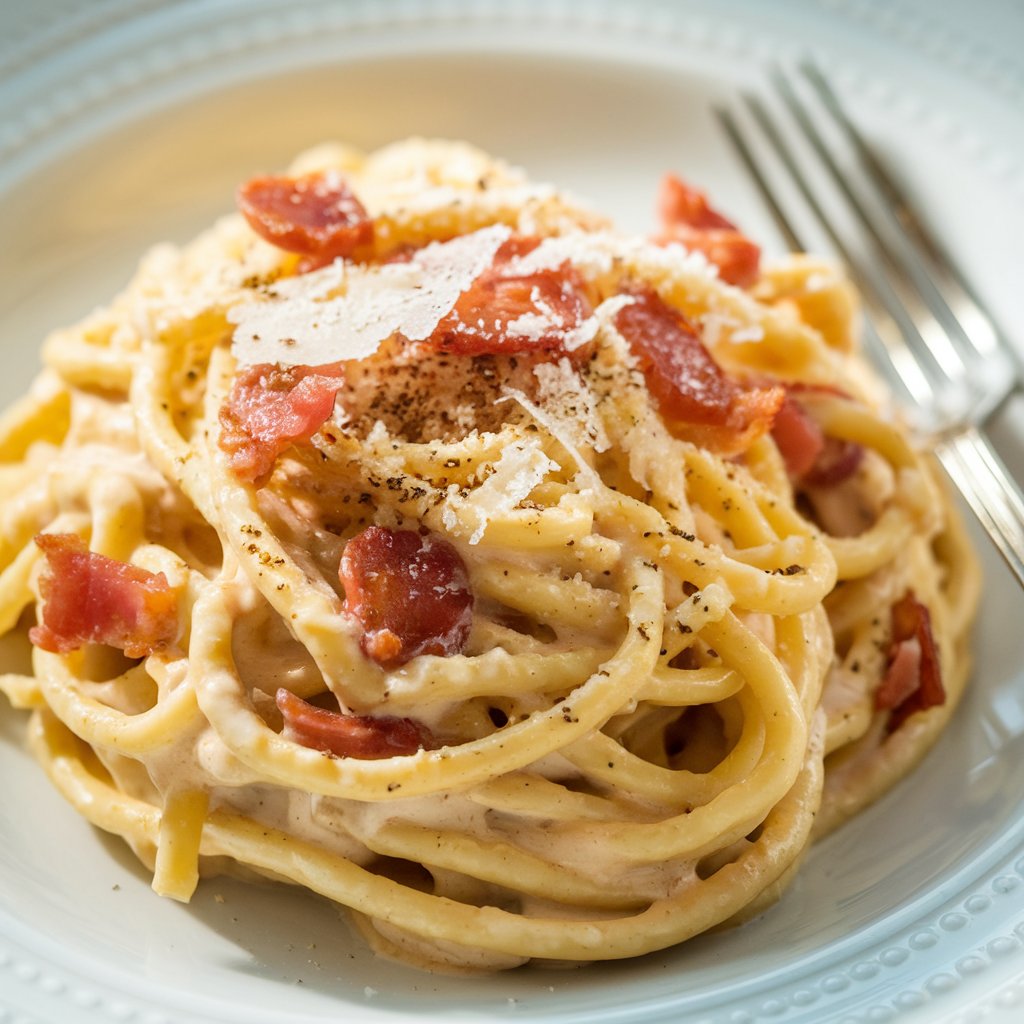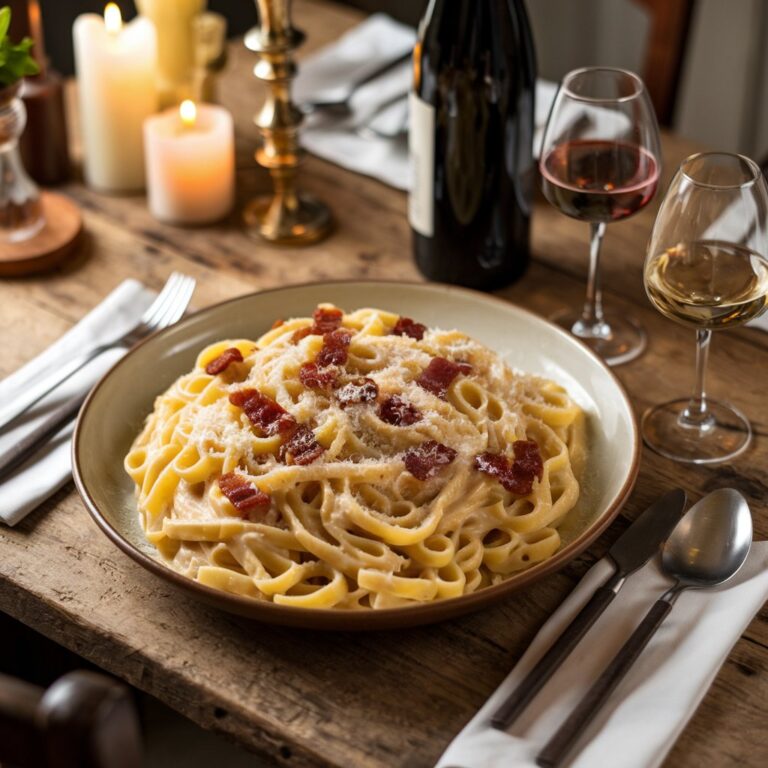
The Ultimate Pasta Carbonara Recipe: A Traditional Italian Dish Made Simple
ملاحظات
The Ultimate Pasta Carbonara Recipe: A Traditional Italian Dish Made Simple

Pasta Carbonara is one of Italy’s most beloved dishes, and for good reason. With its creamy, savory sauce made from eggs, cheese, and pancetta, it’s a comforting and flavorful meal that can be prepared quickly with a few basic ingredients. While many variations of carbonara exist, today we’ll be focusing on the classic, traditional version. In this comprehensive guide, you’ll find everything you need to know to make the perfect pasta carbonara, from ingredients to cooking tips, along with some interesting nutritional insights.
Ingredients: What You’ll Need to Make Pasta Carbonara
The beauty of pasta carbonara lies in its simplicity. You don’t need a lot of ingredients, and yet the flavor is incredibly rich and satisfying. Here’s what you’ll need:
Carbonara Sauce:
- Eggs (4 large, preferably free-range or organic)
- Pecorino Romano cheese (1 cup, finely grated)
- Parmigiano-Reggiano (½ cup, finely grated, optional for added richness)
- Freshly ground black pepper (to taste, 1-2 teaspoons)
- Salt (for pasta water, to taste)
Pasta:
- Spaghetti (400g / 14 oz, you can also use other pasta like fettuccine, rigatoni, or bucatini)
Pork:
- Guanciale (150g / 5 oz, diced) – This is the traditional choice, made from cured pork cheek. If you can’t find guanciale, pancetta or a high-quality unsmoked bacon can be used as a substitute.
Optional Garnishes:
- Extra Pecorino Romano for sprinkling
- Freshly ground black pepper (for garnish)
Equipment:
- A large pot (for cooking the pasta)
- A skillet (for cooking the guanciale)
- A mixing bowl (for preparing the egg mixture)
- A whisk or fork (to beat the eggs)
- A colander (for draining the pasta)
- Tongs or a pasta spoon (for tossing the pasta)
Step-by-Step Instructions: How to Make Pasta Carbonara
Step 1: Boil the Pasta
Start by bringing a large pot of salted water to a boil. The general rule is to use about 1 tablespoon of salt for every 4 liters (1 gallon) of water. Once the water is boiling, add the pasta and cook according to the package instructions until it is al dente (firm to the bite). Be careful not to overcook the pasta, as it will continue to cook slightly when tossed with the sauce.
While the pasta cooks, you can prepare the other elements of the dish.
Step 2: Cook the Guanciale
While the pasta is cooking, take your diced guanciale (or pancetta, if using) and heat a skillet over medium heat. Add the pork and cook for about 5-7 minutes, stirring occasionally, until it becomes crispy and golden brown. The guanciale will release its fat, which will help flavor the pasta and sauce.
Once the guanciale is crispy, remove the skillet from the heat. This will prevent it from overcooking and becoming too dry.
Step 3: Prepare the Egg Mixture
In a mixing bowl, whisk together the eggs, Pecorino Romano, and Parmigiano-Reggiano (if using) until well combined. Add a generous amount of freshly ground black pepper to the mixture. The pepper adds a nice kick to the dish, and the amount is up to you based on your preference for spice.
It’s important to mix these ingredients thoroughly so that the egg mixture is smooth and well-emulsified. Set the bowl aside.
Step 4: Combine the Pasta and Guanciale
Once the pasta is done, reserve about 1 cup of pasta cooking water (this will help to create a silky sauce). Then, drain the pasta in a colander, making sure not to over-drain (some pasta water clinging to the pasta is a good thing).
Transfer the hot, drained pasta to the skillet with the cooked guanciale. If the guanciale has cooled too much, you can place the skillet back on low heat for a moment to warm it up. Toss the pasta in the guanciale and fat mixture to coat the noodles thoroughly.
Step 5: Make the Carbonara Sauce
This is the key step to perfecting your carbonara: combining the hot pasta with the egg mixture. Remove the skillet from the heat to avoid scrambling the eggs. Gradually pour the egg and cheese mixture over the hot pasta, stirring continuously with tongs or a spoon to ensure it coats every strand of pasta. The heat from the pasta will cook the eggs gently, creating a smooth and creamy sauce.
If the sauce is too thick, gradually add some of the reserved pasta water, a little at a time, until you achieve a creamy consistency. The sauce should cling to the pasta without being too runny.
Step 6: Serve and Enjoy
Once the pasta is well-coated in the creamy carbonara sauce, plate it up. Garnish with extra Pecorino Romano and a few cracks of freshly ground black pepper. Serve immediately while hot, and enjoy the creamy, smoky goodness of your homemade pasta carbonara!
Why Pasta Carbonara Is So Special: The Secret to Its Unique Flavor
pasta carbonara original italian recipe is a dish that is beloved not just for its taste, but also for its history and the skill involved in making it. So, what makes this Italian classic stand out from other pasta dishes?
The Simplicity of the Ingredients
At its core, pasta carbonara is a relatively simple dish with few ingredients: eggs, cheese, pork, pasta, and pepper. However, it’s the quality of these ingredients and how they come together that makes carbonara so special. Guanciale, a type of Italian cured pork cheek, is a key ingredient in pasta carbonara original italian recipe, imparting a unique depth of flavor that is hard to replicate with other pork products like bacon. Pecorino Romano cheese, with its salty and tangy flavor, blends seamlessly with the eggs to create a rich, creamy sauce without the use of cream.
The Technique: Tossing the Pasta with the Eggs
The real magic of carbonara happens when the hot pasta is combined with the egg mixture. The heat from the freshly drained pasta gently cooks the eggs, creating a silky, velvety sauce that clings to every strand. This delicate balance of timing and technique is what separates a mediocre carbonara from an exceptional one.
The Perfect Balance of Flavors
Carbonara achieves a perfect balance of flavors: the saltiness of the Pecorino Romano, the smokiness from the guanciale, the richness of the egg yolks, and the heat from the black pepper. It’s a dish that hits all the right notes—creamy, savory, and a little bit spicy, with the texture of the pasta providing just the right bite.
Variations and Substitutes: Making Pasta Carbonara Your Own
While pasta carbonara original italian recipe is made with a handful of ingredients, there are plenty of ways to customize this dish to suit your personal preferences, dietary restrictions, or what you have on hand. Here are a few ideas:
- Vegetarian Carbonara: Swap out the guanciale for mushrooms (shiitake or cremini), which can be sautéed until crispy and golden.
- Low-Carb Carbonara: Use zucchini noodles, spaghetti squash, or shirataki noodles instead of pasta for a low-carb version.
- Using Pancetta or Bacon: If guanciale is unavailable, pancetta or unsmoked bacon are great substitutes, though they lack the depth of flavor from guanciale.
- Add Fresh Herbs or Greens: For a pop of color and flavor, try adding fresh parsley, basil, or arugula before serving.
Benefits of Pasta Carbonara
While pasta carbonara is undeniably rich, it does offer some nutritional benefits when made with high-quality ingredients:
- Protein-Rich: Eggs provide protein for muscle growth and repair.
- Calcium and Nutrients: Pecorino Romano and Parmigiano-Reggiano are excellent sources of calcium, essential for strong bones and teeth
Learn more :

